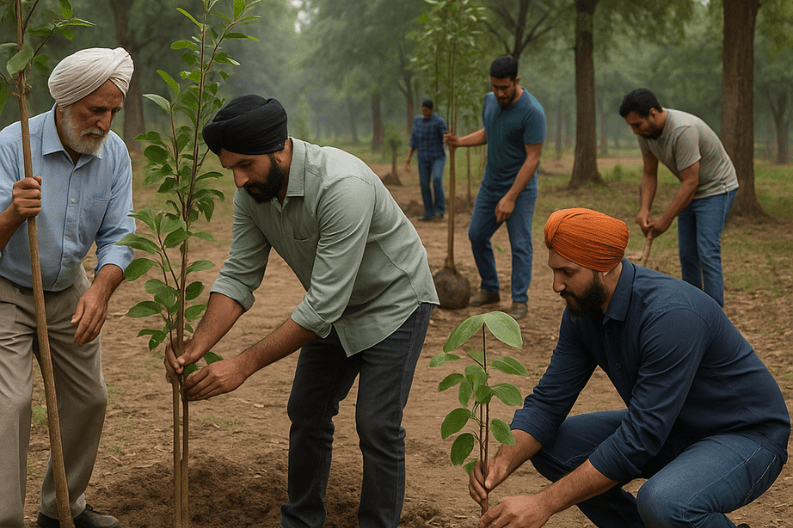Daily News
Landowners Ready to Join Forces to Plant 1000 Trees in Jalandhar
After many protests and concerns from the community, landowners in Jalandhar have made an important agreement with environmentalists.

After weeks of protests and growing public concern, Landowners ready to join forces to plant 1000 trees in Jalandhar. This decision follows the illegal cutting of around 100 trees on the Jalandhar Cantt Bypass Road on September 28 and 29, which sparked outrage among environmental activists and local residents. They even reached out to the Chief Minister and staged protests near the site, demanding immediate action to restore the city’s lost greenery.
In a positive development, landowners have now agreed to a large-scale replantation effort. They will plant 1,000 fully grown trees, each 8 to 10 feet tall, not only at the affected site but also within a 5-kilometer radius in nearby areas, including Kot Kalan, Khusropur, Sofi Pind, and Kukkar Pind. These trees will be provided free of cost by the landowners. And showing a strong commitment to restoring the local ecosystem and repairing the environmental damage.
The tree species selected for planting are all native and beneficial to the local environment. They include Arjun, Moringa, Neem, Amaltas, and Peepal. Authorities and activists have strictly excluded ornamental plants to ensure the project’s ecological value. The landowners have also pledged to care for the trees for at least one year. Their plan includes regular watering, weed removal, trimming damaged branches, and replacing any tree that does not survive.
The planting will begin in February or March next year, a time considered ideal for tree growth in the region. Meanwhile, activists have already planted 50 mature trees at the site, which will soon be protected by tree guards to ensure their healthy growth. The remaining trees will be sourced from Ajanta Nursery in Malerkotla, known for cultivating robust, well-nurtured saplings.
Environmentalists and local residents will work together to choose the best planting locations. This cooperation shows how a united community effort can transform an environmental setback into an opportunity for restoration. Tejasvi Minhas, a prominent environmentalist who exposed the illegal tree cutting by a mall owner, expressed his appreciation. He stated, “I appreciate the landowners’ decision to compensate for the damage. Punjab has the lowest tree cover in India, so every effort to increase it is essential. These 1,000 trees will improve air quality, support biodiversity, and strengthen our environment.”
Landowners have also pledged to support future initiatives beyond this replantation project. They expressed their commitment to preserving the environment and plan to plant more trees around their projects. Their involvement has brought an end to planned protests, as environmentalists now focus on collaborating for a greener future rather than seeking legal action.
This project is especially significant because Punjab’s tree cover is among the lowest in India. Increasing green spaces not only improves air quality but also provides shade, reduces temperatures, and offers habitats for birds and wildlife. Additionally, trees enhance the beauty of neighborhoods and improve mental well-being for residents.
The initiative goes beyond simply planting trees; it demonstrates the power of collective action. When citizens, activists, and landowners work together, they can address environmental challenges more effectively. This replantation effort will benefit future generations and serve as a model for other regions facing similar issues.
As preparations move forward, the project stands as a reminder of what can be achieved when people unite for a common cause. It reflects the shared responsibility to protect the planet and create a sustainable future. Landowners ready to join forces to plant 1000 trees marks the beginning of a greener, healthier chapter for Jalandhar and its people.
Daily News
James Ransone, ‘The Wire’ and ‘It Chapter Two’ Actor, Dies at 46

American actor James Ransone, widely recognized for his memorable performances in “The Wire” and “It Chapter Two,” has died in Los Angeles at age 46. The Los Angeles Medical Examiner confirmed that he died by suicide on Friday.
Early Life and Career Beginnings
Ransone was born in Baltimore in 1979. He attended the Carver Center for Arts and Technology in Towson, Maryland, where he studied from 1993 to 1997. Subsequently, he got his first major break in 2002, co-starring in the teen drama “Ken Park.” This role opened doors for bigger opportunities in his acting career.
Breakthrough Role in ‘The Wire’
Just one year later, Ransone landed his breakthrough role in HBO’s critically acclaimed crime drama “The Wire.” He portrayed Chester “Ziggy” Sobotka, a dock worker who becomes a petty criminal. Moreover, he appeared in all 12 episodes of the show’s second season, and his performance received widespread critical acclaim. Many fans still consider Ziggy one of their favorite characters from the entire series.
Notable Career Highlights
| Production | Role | Year |
|---|---|---|
| The Wire | Ziggy Sobotka | 2003 |
| Generation Kill | Cpl Josh Ray Person | 2008 |
| It Chapter Two | Eddie Kaspbrak | 2019 |
| The Black Phone | Supporting Role | 2021 |
| The Black Phone 2 | Supporting Role | 2024 |
Other Major Roles
Following his success on “The Wire,” Ransone continued working with director David Simon. He appeared in all seven episodes of “Generation Kill,” playing real-life Marine Corporal Josh Ray Person alongside Alexander Skarsgård. Furthermore, he built an impressive resume with roles in various popular shows.
His television credits include “CSI: Crime Scene Investigation,” “Hawaii Five-0,” and “Burn Notice.” Additionally, he appeared in several films, including the indie movie “Tangerine” and Stephen King’s horror film “It Chapter Two.” In the latter, he played Eddie Kaspbrak alongside an ensemble cast featuring Bill Hader, Jessica Chastain, and James McAvoy.
Personal Struggles
In 2021, Ransone bravely opened up about personal challenges he faced. He shared on social media that a former tutor in Maryland public schools had sexually abused him. Moreover, he revealed that this trauma contributed to struggles with alcohol and heroin addiction later in his life.
In 2020, he reported the abuse to authorities. However, they declined to pursue criminal charges, according to the Baltimore Sun.
During a 2016 interview with Interview magazine, Ransone discussed the emotional toll of his profession. He explained that many of his roles required him to humanize unlikable characters. “I find myself living in a lot of unlikable skin,” he said. “As a result of that, I don’t always feel good.”
Tributes Pour In
News of his death prompted an outpouring of grief on social media. Fellow actor François Arnaud, known for “Heated Rivalry” on HBO Max, wrote on Instagram: “RIP James Ransone. Unique actor that I was continuously impressed and inspired by.”
Fans praised his versatility and dedication to his craft. Many specifically highlighted how his performance in “It Chapter Two” stood out even among Hollywood’s biggest stars.
James Ransone leaves behind a legacy of powerful performances that touched audiences worldwide. His talent, honesty, and courage in sharing his personal struggles will be remembered by fans and colleagues alike.
Daily News
Harmanpreet Kaur Creates History: First Indian Woman to Play 350 International Matches

India captain Harmanpreet Kaur made history on December 21, 2024, by becoming the first Indian woman cricketer to play 350 international matches. She achieved this remarkable milestone during the opening T20I against Sri Lanka at the ACA-VDCA Cricket Stadium in Visakhapatnam.
A Journey Starting in 2009
Kaur began her international cricket career against Pakistan in 2009. Since then, she has evolved into one of the most important players for India. Moreover, her fearless batting style and strong leadership have made her a role model for young cricketers across the country.
Throughout her career, she has represented India across all three formats of the game. Her 350 matches include 183 T20Is, 161 ODIs, and 9 Test matches. This achievement demonstrates her incredible longevity and consistency at the highest level.
Where Does She Stand Globally?
With this milestone, Kaur now ranks second on the all-time list for most international appearances in women’s cricket. She trails only New Zealand’s Suzie Bates, who holds the record with 355 matches. Additionally, she has moved ahead of Australian legend Ellyse Perry, who has played 347 matches.
Most International Matches (Women’s Cricket)
| Rank | Player | Country | Matches |
|---|---|---|---|
| 1 | Suzie Bates | New Zealand | 355 |
| 2 | Harmanpreet Kaur | India | 350 |
| 3 | Ellyse Perry | Australia | 347 |
| 4 | Mithali Raj | India | 333 |
| 5 | Sophie Devine | New Zealand | 305 |
Career Highlights
Kaur’s career features several unforgettable moments. Perhaps her most iconic performance came in the 2017 World Cup semi-final against Australia. She scored an unbeaten 171 runs, which remains one of the greatest innings in women’s cricket history. Furthermore, that knock helped India reach the World Cup final for the first time.
Recently, she achieved another historic milestone by leading India to their first-ever ICC ODI World Cup title in 2025. This victory fulfilled a long-standing dream for Indian cricket fans and cemented her legacy as a winning captain.
Beyond her batting prowess, Kaur has also contributed significantly with the ball. She has taken 75 international wickets, proving her value as a genuine all-rounder.
Statistical Impact
Over her 15-year career, Kaur has accumulated impressive numbers:
- Over 8,000 international runs across all formats
- 8 international centuries
- 75 wickets with her off-spin bowling
- Leading run-scorer in several crucial matches
These statistics showcase not just her longevity but also her consistent performance under pressure.
Return After World Cup Glory
The match against Sri Lanka marked India’s first appearance since their World Cup triumph last month. At the toss, Kaur explained her decision to bowl first: “Dew will be a factor here, and secondly, we are playing with 3 pacers.”
She also introduced debutant Vaishnavi Sharma, a U19 World Cup star, into the team. “We always talk about playing fearless cricket,” Kaur said, emphasizing her team’s aggressive approach.
Harmanpreet Kaur continues to inspire millions while leading from the front. As she approaches Suzie Bates’ record of 355 matches, cricket fans eagerly anticipate more memorable performances from this legendary Indian cricketer.
Daily News
Woman Birthday Cake Zomato Error: Delivery Instruction Gets Iced on Birthday Cake

A birthday celebration became an internet sensation after a simple delivery instruction turned into an unexpected cake decoration. The woman birthday cake Zomato error shows what happens when communication between customers and vendors goes hilariously wrong.
What Happened?
Nakshatra was celebrating her birthday when a friend ordered a cake through Zomato. However, instead of receiving a sweet birthday message, she got something completely different. The cake arrived with “leave at security” written on it in frosting.
Typically, customers use this phrase as a delivery instruction for gated communities. Delivery agents see these notes to know where to drop off orders. Unfortunately, the bakery staff mistakenly thought this instruction was the actual message meant for the cake.
The Viral Moment
Nakshatra captured the entire moment on video and shared it on Instagram. In the clip, someone places the cake in front of her during the party. Initially, she looks shocked when reading the unusual message. Then, she bursts into laughter along with everyone around her.
She explained the mix-up in her caption: “So it was my birthday. My friend ordered cake from @zomato and the cake guy literally mentioned ‘leave at security’.”
View this post on Instagram
Why It Went Viral
The video quickly gained massive attention online, receiving over one million views. People found the mistake both amusing and relatable. Moreover, many viewers shared their own similar experiences with food delivery apps.
Similar Cake Mishaps
Interestingly, this isn’t an isolated incident. Many people commented with their own stories:
| Customer Instruction | What Got Written on Cake |
|---|---|
| “Write happy birthday mom” | “Write happy birthday mom” |
| “Handle with care” | “Handle with care” |
| “Happy anniversary topper” | “My sister” + wrong topper |
| “Should be Ameer” | “Should Be Ameer” |
| “Please put bye on cake” | “Please put bye on cake” |
Furthermore, these mistakes happen because bakery staff sometimes don’t distinguish between delivery instructions and actual cake messages. Additionally, language barriers or rushed work environments can contribute to such errors.
Social Media Reactions
The comment section filled with hilarious responses. One user joked, “Zomato never fails on their delivery instructions.” Another wrote, “This is the most honest cake I have ever seen.”
Meanwhile, someone else commented, “Security deserves a slice for being mentioned like this.” Others noted that the mistake actually made the birthday more memorable than a regular celebration would have been.
Lessons From the Mix-Up
This incident highlights several important points about online food ordering:
- Clear Communication: Customers should clearly separate delivery instructions from cake messages
- Double-Check Orders: Always review custom message sections before confirming
- Platform Improvements: Food apps could create separate fields for delivery notes and product customization
- Human Error: Despite technology, human mistakes still happen
Nevertheless, the woman birthday cake Zomato error shows that sometimes mistakes create better memories than perfect execution. Rather than ruining the celebration, the unexpected message gave everyone a good laugh and created a story worth sharing.
The clip serves as a lighthearted reminder that even when things don’t go as planned, they can still turn out entertaining. In fact, this birthday cake mistake brought joy not just to the party guests, but to millions of people online who needed a good laugh.
-

 City Guide3 years ago
City Guide3 years ago3B2 Mohali Market Shops: Discover 44 Hidden Gems
-

 Entertainment2 years ago
Entertainment2 years agoTop 15 Punjabi Models – Male and Female List
-

 Entertainment3 years ago
Entertainment3 years agoTop 11 Punjabi Comedians of All Time
-

 Jobs4 years ago
Jobs4 years agoTop 20 IT Companies in Mohali
-

 Food4 years ago
Food4 years ago11 Best Restaurants in Mohali You Must Visit
-

 Property2 years ago
Property2 years agoWho Lives In Homeland Mohali: Punjabi Celebrities, Business People…
-

 Food3 years ago
Food3 years agoTop 15 Cafes in Mohali you must visit
-

 Education2 years ago
Education2 years ago10 Famous Punjabi Writers With A Great Impact On The Literary World
